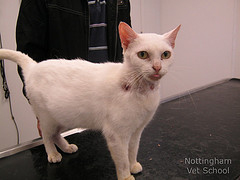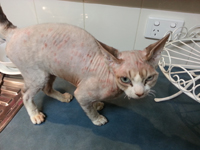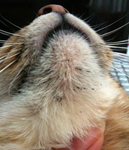CB,
I found this:
Scabs on Cats - Causes, Symptoms and Treatment
Table of contents
Common causes of scabs on cats Diagnosing the cause of scabs Notes
Scabs are dry, rough crusty patches that are formed when a wound heals. There are a number of causes of scabs on your cat.
Often scabs will be described as crusty lesions or pustules and may range from singular to multiple (dozens). The type of scabs, location and accompanying symptoms can all give your veterinarian an indication of the possible cause.
- Scabs around the neck and back (especially close to the tail) can be indicative of flea bite hypersensitivity. These may present as a singular lesion or more commonly miliary dermatitis which is characterised by a collection of crusty red bumps which are often accompanied by intense itching.
- Scabs around the head and ears may be associated with food allergies.
- Chin scabs are usually caused by feline acne.
- Non-seasonal itching, scratching and scabs are commonly caused by allergies.
Untreated, scabs can lead to secondary bacterial infections, so it is always important to have any scabs, lumps, bumps or rashes seen by a veterinarian.
Flea bite hypersensitivity
The most common causes of scabs on your cat is flea bite hypersensitivity. Cat fleas are wingless parasites, the adult flea lives on the cat's skin, feeding off his blood. Many cats develop an allergy to the saliva in flea bites, causing a localised reaction.
Symptoms: Small, raised scabs can be found on the rear of the cat (just in front of his tail) and around the neck and chin. As the cat scratches the skin becomes further damaged, resulting in bleeding, especially around the neck (see image). Scabs can range in size from 3mm to 1-2cm or more.
Treatment for flea bite allergy is diligent flea control. Not only must you keep your pet flea free, but the environment must also be treated as 90% of the flea's lifecycle is spent off the cat and in the environment.
Antihistamines can help to control the itchiness.
I have battled FAD in one of my cats for quite some time. Recently I switched them over to Comfortis (Spinosad), a once a month tablet and his condition cleared up completely.
Food allergy
Cats can develop allergies to a number of things including food.
Symptoms: Food allergies typically affect the head and neck area, causing itching, which may progress to small papules and scabs. Other symptoms may include hair loss, vomiting, and excessive licking of the affected area. Food allergy may be suspected if itching is non-seasonal.
Treatment: If a food allergy is suspected, your cat will be put on a "novel" diet (ie; a type of food he's not had before such as duck or kangaroo) to see if the symptoms clear up. He will then be "challenged" by going back on to his usual diet, if the symptoms return, food allergy is the cause. Treatment involves switching your cat to a different "
hypoallergenic" diet.
Contact dermatitis
Contact dermatitis occurs when your cat comes into contact with an irritant such as soaps, shampoos, plants, medications etc.
Symptoms: Common symptoms of contact dermatitis includes non-seasonal itching, which can cause damage to the skin and formation of small scabs on the skin. Commonly affected areas include areas without much fur such as the ears, underbelly, paws etc.
Treatment involves removing the irritant if possible and antihistamines and/or steroids to help control the itch.
Mange
Also known as
feline scabies, mange is a highly contagious condition caused by a tiny spider-like parasite which burrows into the cat's skin.
Symptoms: Intense itching and scabs, especially along the ear margin which may become thickened. The head and neck are the most commonly affected areas, although left untreated, the mite can move to other parts of the body.
Treatment may include clipping longhaired cats and treating with a medicated dip to kill the parasites.
Demodicosis
Another type of mite which can infect cats is the demodex mite, there are two species which infect cats. Demodex cati and Demodex gatoi. These mites are seen commonly in dogs, but less often in cats. Immunocompromised cats are at greatest risk.
Symptoms: Itching, overgrooming, single or multiple areas of thinning hair along with crusting fluid filled sores. The head, neck and ears are most commonly affected.
Treatment for demodicosis may include lime sulfur dips or oral Ivermectin. All cats in the household should be treated as well as any bedding or blankets your cats use.
Ear mites
Caused by the mite
Otodectes Cynotis, ear mites are a common and highly infectious spider-like parasite which as the name suggests, infect the inner ears of cats.
Symptoms: Intense itching, waxy build up, coffee like grounds in the ears, and eventually damage due to trauma from scratching and a secondary bacterial infection may develop. Kittens and outdoor cats are most commonly affected although cats of any age can become infected.
Treatment for ear mites includes daily removal of the exudates within the ears as well as a commercial insecticide to kill the mites. There are several products which can be used to kill ear mites including Selamectin (Revolution), Ivermectin (Acarexx) and Milbemycin (MilbeMite).
Ringworm
Ringworm is a highly contagious fungal infection. It is most often seen in young cats or over crowded environments such as catteries and shelters.
Symptoms: The appearance of bald patches of circular lesions. Lesions may become itchy, which leads to the formation of scabs. Ringworm lesions are typically larger than most other causes of scabs in this article.
Treatment: Your veterinarian will prescribe a shampoo or dip to treat ringworm. As it is highly contagious, all animals in the house should be treated. Ringworm can be passed on from cats to people and vice versa, so care must be taken when treating ringworm to avoid infection. If you do become infected, over the counter creams are available at your chemist.
Feline acne
Feline acne is characterised by a collection of blackheads (comedones) under the chin.
Symptoms: The appearance of blackheads on the chin, which often have the appearance of dirt. Blackheads can become inflamed and form crusts, scabs and swelling.
Treatment for feline involves keeping the area clean with an antibiotic soap, Betadine or in more severe cases ointments or gels which contain benzoyl peroxide such as OxyDex. Oral antibiotics may be prescribed if secondary infection is present. Switch from plastic to glass or metal bowls. Stringent hygiene must be practiced and food bowls should be washed after every use. Topical steroids may be prescribed to control the itching.
Abscess
An abscess is a walled off pocket of pus under the skin. Most commonly caused by a cat fight, these are especially common in cats who are allowed to free roam outside, especially entire males who are prone to fighting.
Symptoms: If the abscess hasn't drained, there will be a hot extremely painful lump under the skin your cat may also have a fever, and go off his food. If it bursts and drains, there will be a foul odour, as well as discharge. Once this has occurred the wound will form a scab.
Treatment: An abscess should be lanced by a veterinarian and cleaned, your cat will then be put on a course of antibiotics.
Stress
Cats display signs of stress in many ways and there are many causes of stress in cats including changes in the home environment, new pet, family member, moving house.
Symptoms: Stress manifests in many ways, some cats will hide, or go off their food, other cats will engage in excessive grooming (known as
overgrooming). This can lead to damage to the skin and the formation of crusty scabs on the coat. Stress can be triggered by a change in routine, new family member (animal or human), moving house, sickness.
Treatment: Stress is managed in a number of ways, including removing the cause of stress if possible, giving your cat a regular and set routine.
Play therapy and anti-anxiety medications.
Adverse reaction to topical flea products
Also known as 'spot on', there are a number of products on the market which are applied to the back of your cat's neck. While they are extremely convenient, some cats can develop a skin reaction.
Symptoms: Loss of hair, redness, rash, ulceration or in severe cases loss of skin.
Treatment may vary depending on the severity of the damage, but may include antibiotics to prevent secondary infection and painkillers. If your cat has had an adverse reaction to a topical flea product, there are a number of alternatives such as tablets and chews.
Bacterial infections (pyoderma)
Pyoderma is an infection of the skin which can develop due to trauma, such as itching and scratching which damages the area.
Symptoms: Irritation and inflammation of the skin result in crusty pustules. Cats with a weakened immune system are more at risk of developing pyoderma and it is known to be an opportunistic infection.
Treatment involves a course of oral antibiotics as well as topical antibiotics applied to affected area to clear up the infection and addressing the underlying cause (if known).
Eosinophilic granuloma
A condition characterised by the presence of skin lesions on various parts of your cat's body. The exact cause isn't known but it is believed it may be the result of certain allergens such as flea bites, food or inhalant allergens. Some cats may only have one outbreak, while in others the condition can come and go. There are three types of lesions:
- Indolent ulcer (also known as rodent ulcer) most often occur on the upper lip with a raised, thickened area which is well defined and glistening,
- Eosinophilic plaque can occur on any part of the body and appear as a raised, hairless lesion which may be ulcerated
- Eosinophilic granuloma which appears as a yellow/pinkish lesions usually along the back legs. Male cats are most often affected with eosinophilic granulomas.
Treatment includes removing exposure to allergens if possible, including diligent flea control and food elimination trials. Zyrtec, an antihistamine has been show to help relieve symptoms. If there is no remission then steroids may be prescribed. Steroids to reduce inflammation and in severe cases interferon, an immunosuppressive drug. If lesions are unresponsive, surgical removal may be necessary.
Insect bite or sting
Insect bites and stings can cause a localised reaction which leads to intense itching.
Symptoms: Scratching which can damage the skin resulting in a wound which heals and scabs over. If you notice one or two small scabs on your cat, it is likely to be caused by a bite or a sting.
Treatment: Benadryl (antihistamine) can be used to control itching and discomfort in cats who have severe reactions. Dosage is 1 milligram (mg) per pound, or 2 mg per kilo, twice a day.
Sunburn
Cats are prone to developing sunburn on areas of their body with thin or no fur such as the ear tips and nose. Light coloured cats are particularly at risk due to their lack of pigment.
Symptoms of sunburn include reddening and hair loss of the affected area, more severe cases may develop itching and thickening of the skin. Over time, this may become damaged and form sores which dry into scabs.
Treatment: Severe sunburn may be treated with topical or oral steroids and antibiotics may be necessary to treat secondary bacterial infections.
Sunburn should be avoided by keeping cats confined during the warmer part of the day. Anybody who has experienced sunburn knows how painful it is, and just like humans, cats can develop cancer from exposure to the sun (see below).
Sqamous cell carcinoma
This is due to a malignant tumour of the skin and is most commonly caused by excess sun exposure. Any part of the cat's body can be affected, but areas with little or no skin are most at risk, that includes the ear tips and the nose. As with sunburn, cats with light coats are at greater risk due to the lack of melanin in the skin.
Symptoms of squamous cell carcinoma include red and crusted sores, bleeding ulcers which won't heal and hair loss.
Treatment includes surgery to remove the affected area and chemotherapy or radiation therapy.
Pemphigus complex
A group of rare auto immune skin disorders affecting the skin. There are three types of pemphigus in cats depending on the layer of skin involved.
- Pemphigus foliaceous which affects the top layer of skin.
- Pemphigus erythematosus, the second most common form which affects the head and feet.
- Pemphigus Vulgaris the rarest form in which lesions grow on the mouth, claw folds, armpits, and groin.
Symptoms vary depending on the type but may include distribution of pustules around the mouth, face, neck, feet, and groin with crusts and hair loss.
Treatment for pemphigus may immunosuppressive drugs such as oral prednisolone, or in milder cases topical steroids. If remission isn't achieved then chlorambucil, a chemotherapy drug may be prescribed. Antibiotics may be prescribed if a secondary infection is present.
Antihistamines can help to relieve itching associated with allergies. They are not a cure, but can help short term.




